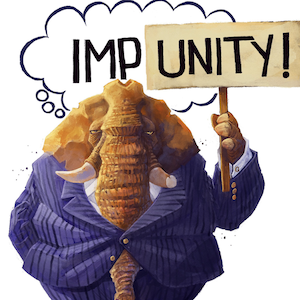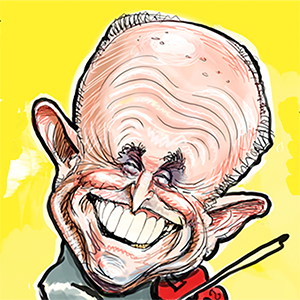Though home to about 50 white extremist groups, Ohio’s social and political landscape is undergoing rapid racial change
Published in Political News
The first time many Americans heard about Springfield, Ohio, came during the September 2024 presidential debate when Donald Trump falsely claimed that Haitian immigrants in the city were eating other residents’ cats and dogs.
Though shocking, these harmful rumors had been spreading on social media since the beginning of the summer and had gained more notoriety when JD Vance, a U.S. senator from Ohio and Trump’s running mate, made similar statements on X, the social media platform formerly called Twitter.
But what has gone mostly overlooked is the effect these racist lies have had on energizing Ohio’s nearly 50 white extremist groups.
Members of the white supremacist group Blood Tribe marched through Springfield on Aug. 10, 2024, with with swastikas on their signs.
Since then, members of the Ku Klux Klan and the right-wing extremist group Proud Boys have each marched in separate demonstrations through Springfield.
As scholars of extremism who live in Ohio and work at the University of Dayton, we have seen these events unfold at a time when city officials have received multiple bomb threats targeting local government offices and schools since Trump’s false and racist claims against Haitian immigrants.
In our research, we have found that the rapidly changing social conditions in Ohio have played a significant role in the growth of extremism.
Between 1990 and 2019, for instance, manufacturing jobs shrank from 21.7% of all employment in the state to 12.5%, a loss of nearly 360,000 jobs. As a result, income disparities between the professional and working classes have widened – as has the heightened sense among some alienated white men that white conservatives are the real victims of bias in a society growing more racially and culturally diverse.
For many of these alienated men, particularly those in rural areas that lack significant numbers of Black and Hispanic residents, extremist ideologies offer easy answers to complex questions that involve their sense of disenfranchisement.
In 2020, for example, the population of Springfield was about 60,000. But over the past three years, city officials estimate that the population has grown by about 25%, partly fueled by the arrival of as many as 15,000 Haitian immigrants during that time. Many of them are legally living in the U.S. under a special federal program.
Similar demographic shifts are occurring throughout the state. Between 2010 and 2022, the percentage of the white population dropped from 81.2% to 77.3%, a loss of about 250,000, putting the state’s white population at about 9.1 million. During the same time, the Hispanic population, for instance, grew from about 357,000 in 2010 to nearly 525,000.
For some of these white extremists, these population changes will lead to an inevitable race war between white people and nonwhite people. We have found that the attraction of belonging to a group that promises strength, protection and a source of identity can be particularly compelling.
In recent years, white extremism in Ohio has received attention as a result of the extremist rhetoric of and often violent crimes committed by white men who call the state home. Consider just a few examples:
Born and raised in Ohio, Andrew Anglin founded the Daily Stormer, a popular neo-Nazi website, in 2016.
James Alex Fields Jr., a white nationalist from the Toledo area, was sentenced to life in prison in 2019 for the murder of Heather Heyer in Charlottesville, Virginia. Fields was convicted of driving his car into a crowd of counterprotesters during the white nationalist Unite the Right Rally in August 2017.
Prior to the attack, Fields frequently posted the hashtag #Hitlerwasright on his social media accounts and called for violence against nonwhites and Jews.
In the summer of 2022, Ohio law enforcement officers shot and killed Ricky Shiffer after the armed Navy veteran fired a nail gun at the FBI field office in Cincinnati. On his social media accounts, Shiffer had called for violence against federal law enforcement officials after the FBI searched Donald Trump’s residence at Mar-a-Lago as part of the federal probe into Trump’s handling of classified documents.
Tres Genco, a self-described incel – short for “involuntary celibate” – who hated women and believed he was owed sex from them, was from the Cincinnati area and pled guilty in 2022 to plotting a mass shooting of women at Ohio State University. Law enforcement officials in Ohio stopped the planned attack before it happened.
On April 21, 2023, Christopher Brenner Cook, 20, of Columbus, Ohio, and others were sentenced to nearly eight years in prison for his plan to attack power grids across the U.S. Cook and his accomplices believed that they were starting a race war and used neo-Nazi propaganda and white supremacist ideology to recruit young people to join their group.
Leaders of white supremacist and militia groups often use both traditional outreach and digital platforms to recruit people to their groups. Traditional outreach includes recruitment in conversations, attending events, and sharing books, pamphlets, flyers and posters.
At the same time, social media has become a critical tool for extremist groups to spread their message, recruit members and organize events.
These online platforms create echo chambers that reinforce extremist beliefs in debunked conspiracy theories, such as the assumption that the federal government is part of a plot to eliminate the white race.
In addition to the increased traffic on social media, we have seen a rise of extremist groups in Ohio known as active clubs, where members engage in physical fitness, combat training and emotional support that encourages the development of a warrior mentality in preparation for what followers believe is an inevitable race war.
Though the emergence of white extremist groups goes far beyond the borders of Ohio, we have found that community-based, educational initiatives are effective in understanding and ultimately eradicating the root causes of racial and ethnic hatred on the local level.
In our view, community engagement that emphasizes dialogue and understanding across different racial groups is crucial for demonstrating the dangers of intolerance – and the benefits of diversity.
This article is republished from The Conversation, a nonprofit, independent news organization bringing you facts and trustworthy analysis to help you make sense of our complex world. It was written by: Paul J. Becker, University of Dayton and Art Jipson, University of Dayton
Read more:
Faced with a rise of extremism within its ranks, the US military has clamped down on racist speech, including retweets and likes
White supremacists who stormed US Capitol are only the most visible product of racism
White power movements in US history have often relied on veterans – and not on lone wolves
Paul J. Becker is part of a team at The University of Dayton that received funding from the Department of Homeland Security for the Preventing Radicalization to Extremist Violence through Education, Network-Building and Training in Southwest Ohio (PREVENTS-OH) project. Funded by the Department of Homeland Security under the Targeted Violence and Terrorism Prevention (TVTP) Grant Program, PREVENTS-OH recognizes that domestic violent extremism and hate movements pose a serious threat to the realization of human rights.
Art Jipson is part of a team at The University of Dayton that received funding from the Department of Homeland Security for the Preventing Radicalization to Extremist Violence through Education, Network-Building and Training in Southwest Ohio (PREVENTS-OH) project. Funded by the Department of Homeland Security under the Targeted Violence and Terrorism Prevention (TVTP) Grant Program, PREVENTS-OH recognizes that domestic violent extremism and hate movements pose a serious threat to the realization of human rights.


































































Comments